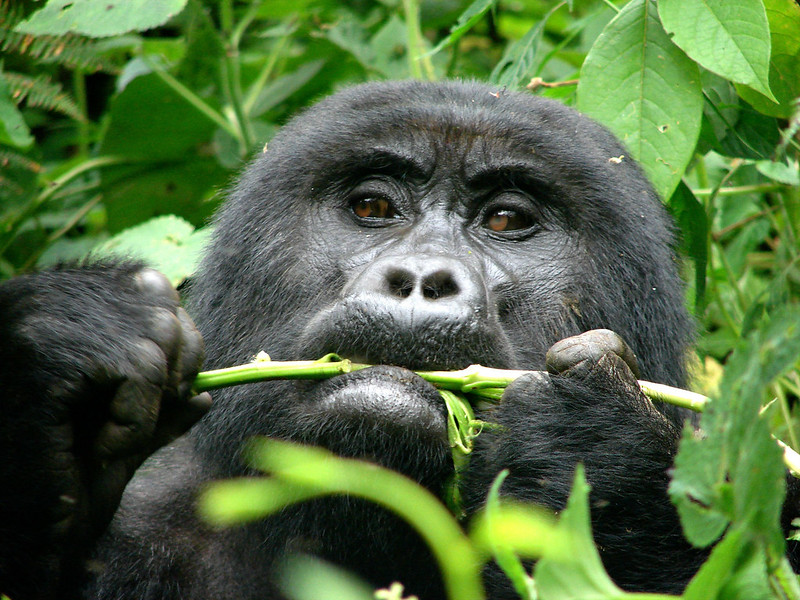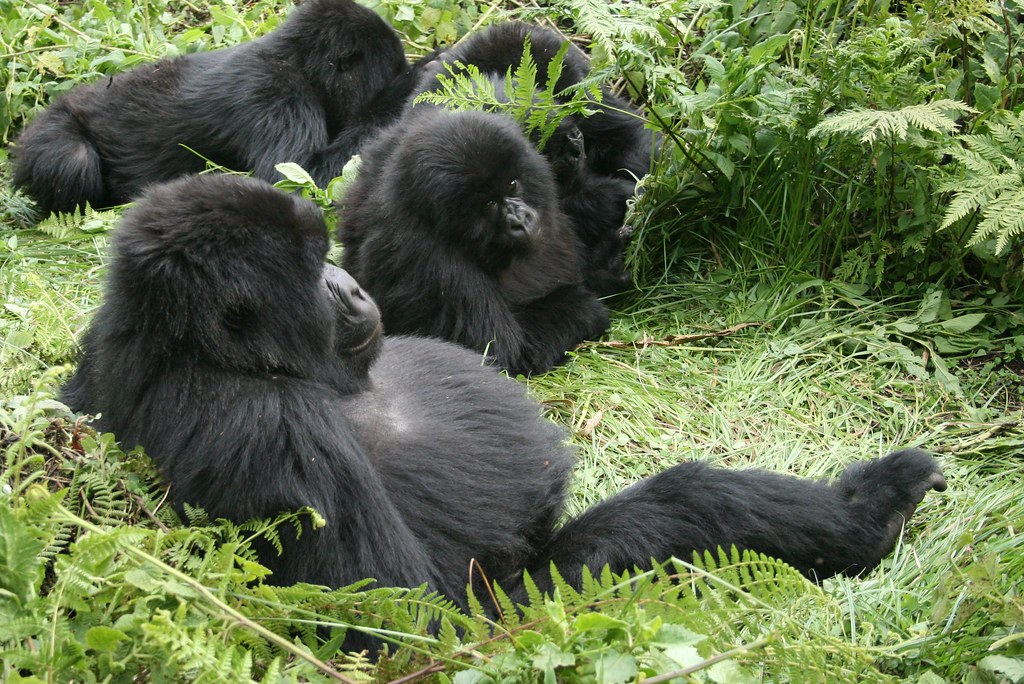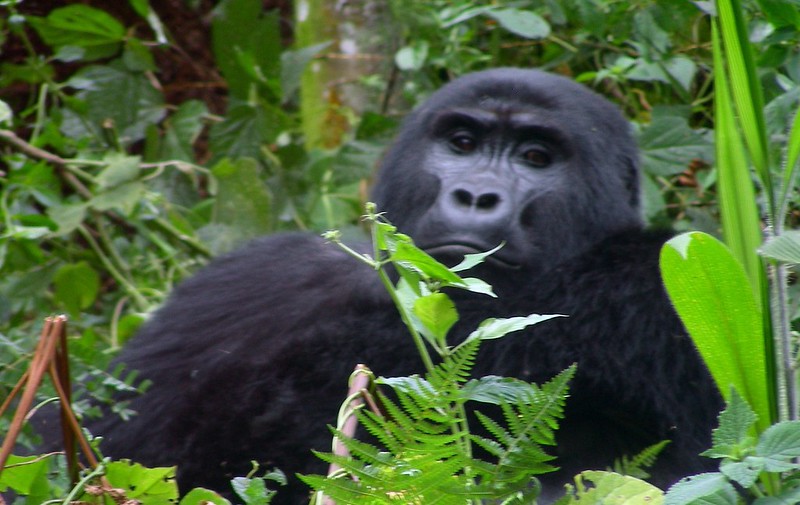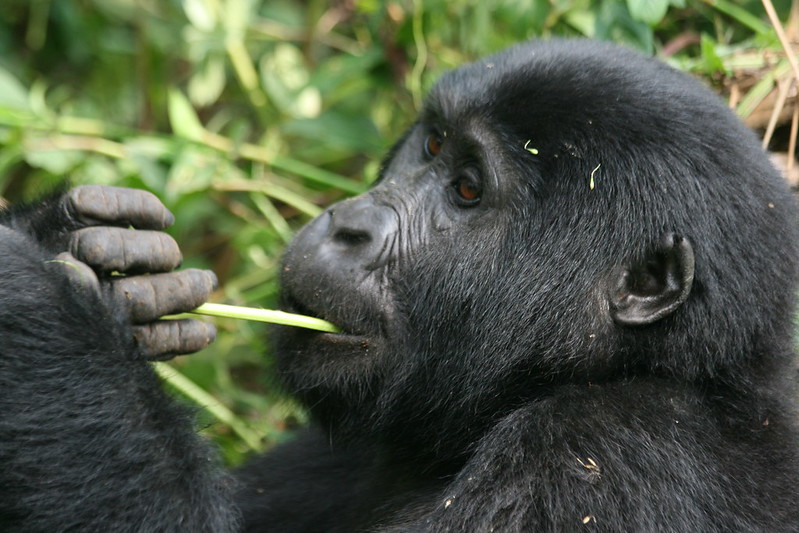Mountain Gorilla Diet ,What food Do Gorillas Eat?
Mountain Gorilla Diet, the close proximity of mountain gorillas to humans and their endangered status raises questions about their dietary habits that contribute to their strength. Another reason individuals question the dietary habits of mountain gorillas is their inability to thrive in captivity.
Mountain Gorillas inhabit the forests of Virunga National Park in the Democratic Republic of Congo, Volcanoes National Park in Rwanda, and Uganda’s Bwindi Impenetrable National Park and Mgahinga Gorilla National Park. As the largest primate, they require substantial sustenance, predominantly including plant matter. Mountain gorillas are recognized for consuming over 142 plant species, with leaves, shoots, and stems comprising over 86% of their diet.

Edible roots constitute 7% of their diet, flowers 3%, and fruits 2%. Mountain gorillas, residing at elevated altitudes, consume far less fruit compared to lowland gorillas, whose diet predominantly consists of fruit. Gorillas are categorized into two species, each with two subspecies. Western gorillas are divided into two subspecies: Cross River gorillas and Western Lowland gorillas. The eastern gorilla is a species that includes two subspecies: mountain gorillas and eastern lowland gorillas.
What is the diet of Mountain Gorillas?
Gorillas are herbivorous creatures that mostly consume green vegetation, including stems, flowers, buds, bark, seeds, bamboo shoots, fruits, grasses, vines, herbs, roots, leaves, and young branches. Gorillas consume ash and soil to regulate their digestive system, neutralize toxic chemicals in certain plants, and supplement their diet with minerals absent in their plant-based intake.
To acquire proteins, they also consume insects including ants, snails, caterpillars, and termites, among others. Mountain gorillas are occasionally observed consuming ants, snails, and grubs, which constitute 2% of their diet. Mountain gorillas exhibit a fear of water and hence do not consume it independently. The majority of the water required by mountain gorillas is primarily derived from the vegetation and shoots they ingest daily. Consequently, they achieve a balanced diet.
Mountain gorillas are smaller than lowland gorillas and exhibit distinct dietary preferences. They predominantly consume foliage or green plants due to their habitation in high-altitude rainforests, which do not facilitate substantial fruit proliferation, whereas lowland gorillas are marginally larger and largely subsist on fruits.

Mountain Gorilla Diet, In arid seasons, when fruits rapidly descend, they adapt by ascending trees to collect the fruits, and are occasionally necessitated to ingest substantial quantities of seeds and tree bark. Mountain gorillas in Africa’s rainforests ingest more than 142 plant species, with leaves, stems, and bamboo shoots comprising roughly 86% of their diet, edible roots 7%, flowers 3%, fruits 2%, and ants, grubs, and snails 2%.
Information Regarding the Dietary Habits of Mountain Gorillas
Mountain Gorilla Diet, Gorillas possess 32 teeth, similar to humans, which they utilize for mastication and digestion of plant matter. However, adult gorillas develop elongated, pointed canines at reaching maturity, which they employ in combat with other male gorillas. An adult male gorilla ingests around 30 kilos of plants day, whereas a female gorilla consumes about 18 kilograms daily. Mountain gorillas infrequently consume water, as the vegetation they ingest is tender, palatable, and succulent, supplying around fifty percent of their hydration needs for survival. They also obtain water from the morning mist.
Mountain gorillas exhibit selectivity in their plant consumption by not depleting all vegetation in a given area; instead, they consume the roots of one plant, the stems of another, and the leaves of yet another, facilitating the regrowth of the vegetation by continuously rotating their feeding locations. Gorillas can traverse between 3 to 6 kilometers daily in search of sustenance and can also relocate from one site to another.
Gorillas utilize approximately 25 distinct vocalizations, including roars, howls, grunts, screams, growls, hoots, and the distinctive chest beating. Gorillas communicate when seeking food, expressing discomfort, or offering aid to one another. Gorillas are herbivorous creatures who depend exclusively on their surroundings for sustenance, including fruits and foliage, as well as for shelter. These are, nonetheless, essential for their life.
Female gorillas commence parturition between the ages of 10 and 12 years, experience a gestation duration of 8.5 months, and typically deliver one offspring every 2 to 3 years, resulting in a total of 4 to 6 progeny over their lifespan, thereby impeding population growth and complicating the expansion of the gorilla population.
Mountain Gorilla Diet: At birth, newborn gorillas typically weigh between 3 and 4 kilos and consume breast milk for five months, with mothers nursing them hourly until they reach four years of age. Adult male gorillas weigh between 136 and 196 kilograms and measure 5 to 9 feet in height, whilst females weigh between 68 and 113 kilos and reach a height of 5 feet.

How do Mountain Gorillas obtain their sustenance?
Mountain gorillas represent the largest and most formidable primates globally. They employ their considerable strength to dismantle plants in order to extract the desired portion. Gorillas are crucial to their ecological niche due to their selective feeding habits, which prevent the overconsumption of local flora. They facilitate plant regeneration and are consistently relocating from one site to another. Due to their dietary practices, they may be rapidly refilled.
Mountain gorillas are selective foragers, consuming various parts of vegetation. For instance, they may exclusively consume the root of one plant, the stem of another, the leaves of still another, and the fruit of a different one, among others.
Information Regarding the Dietary Habits of Mountain Gorillas
What is the dietary intake capacity of Mountain Gorillas?
An adult mountain gorilla ingests approximately 27 kg of sustenance daily. This is attributable to their substantial physiques, necessitating increased sustenance to generate greater energy. Gorillas predominantly use their time foraging for sustenance or consuming food. They depart from their nocturnal resting sites at dawn and traverse the forest in search of an appropriate location to forage and repose. The silverback gorilla is responsible for guiding the group to a suitable area with sufficient food for all members.
Mountain gorillas consume food bi-daily, throughout the morning and evening. Adult gorillas will repose between meals, while infants will engage in play with one another. Gorillas do not excessively consume food in a single area before relocating. They collect leaves, shoots, stems, buds, and roots for sustenance in a very sustainable manner that does not harm the vegetation they consume.
An exemplary illustration of this phenomenon is that a gorilla refrains from consuming the roots of a plant from which it has already ingested the leaves or buds, opting instead to search out the roots of a different, yet similar, species. Each family of mountain gorillas has a distinct ‘territory,’ and encroaching upon another group’s area is rare and may lead to confrontations as the silverback safeguards his family.
Do Mountain Gorillas possess dietary habits?
Due to their selective feeding practices, Mountain gorillas maintain commendable eating patterns, preventing overconsumption and the depletion of any one forest region during foraging. The plants may swiftly regenerate due to the balanced nourishment. Mountain gorillas swallow only one piece of a plant, specifically its leaves, shoots, or stems, before transitioning to another plant to ingest a new part. This is the method by which mountain gorillas consume food, and it is also how they astutely save their food resources.
Do Mountain Gorillas Eat meat or fish?
Gorillas do not consume meat or fish, yet scientific consensus indicates they are omnivores due to their occasional ingestion of insects such as termites. Their formidable bite serves the dual purpose of masticating vegetation and engaging in sparring with other animals for self-defense.
Do mountain gorillas consume bananas in their natural habitat?
Despite their ability, mountain gorillas and other gorilla species do not ingest bananas in their natural habitat. The primary reason is their inability to locate wild bananas. The thick canopy in the gorilla habitat inhibits banana cultivation. Consequently, most wild gorillas live their entire lives without encountering or consuming a banana.

What is the optimal period for observing Mountain Gorillas in their natural habitat?
Gorillas are accessible year-round; however, the optimal period is the dry season, encompassing June, July, August, September, December, January, and February, characterized by reduced precipitation, firmer terrain for trekking, and enhanced visibility of the gorillas due to shorter vegetation. In contrast, the wet season, spanning March to May and October to November, presents challenges such as increased rainfall, arduous trekking conditions, and slippery, muddy ground, which hinder gorilla observation.
